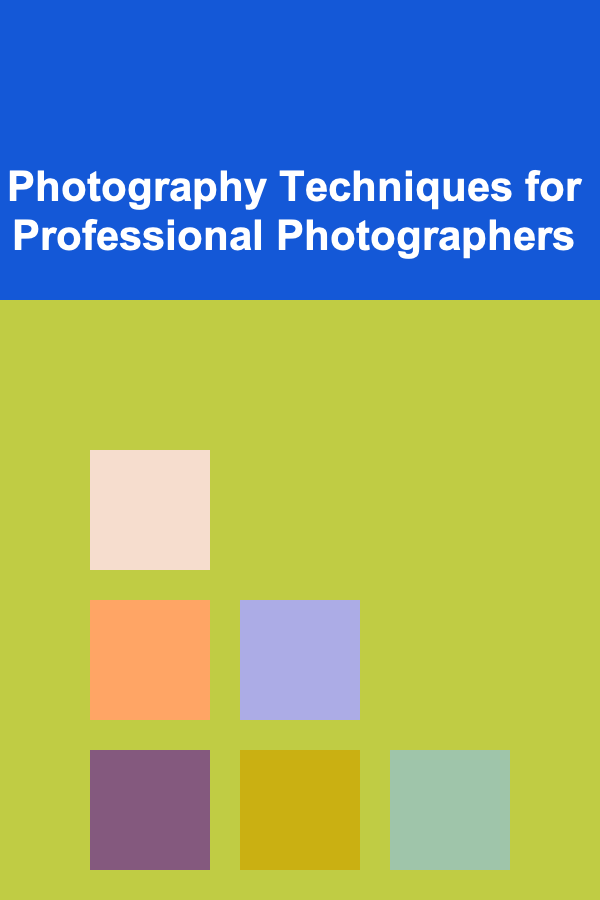
Photography Techniques for Professional Photographers
ebook include PDF & Audio bundle (Micro Guide)
$12.99$8.99
Limited Time Offer! Order within the next:

Photography is an art, a science, and a craft. It's a medium through which you can express your creativity, capture reality, and even alter the perception of the world. For professional photographers, it's not only about mastering the technical aspects but also developing a unique style that sets them apart. Whether you're capturing breathtaking landscapes, intimate portraits, or dynamic action shots, there are certain techniques that every professional photographer should have in their toolkit.
In this guide, we'll dive deep into advanced photography techniques that can elevate your craft, improve your skillset, and help you push the boundaries of your photography. From mastering light to experimenting with focus and composition, these actionable strategies will allow you to create stunning and impactful images every time you press the shutter.
Understanding and Mastering Light
Light is the foundation of every photograph. A professional photographer's ability to manipulate and control light is what distinguishes their work from amateurs. Without light, there is no photograph, and thus learning to work with light is crucial for capturing perfect images.
Natural Light Control
Natural light is free, often available in abundance, and has a unique, organic feel to it. However, its quality and intensity can vary greatly throughout the day. Understanding how to make the most of natural light is an invaluable skill for any photographer.
- Golden Hour: The golden hour, shortly after sunrise and just before sunset, offers warm, soft light that's perfect for portrait and landscape photography. The low angle of the sun during these times adds long shadows, highlighting textures and creating depth.
- Diffused Light: On overcast days, the clouds act as a giant diffuser, softening harsh sunlight and spreading it evenly across the scene. This type of light is ideal for portraits, as it reduces shadows and softens skin tones.
- Backlighting: Backlighting occurs when the light source is behind your subject, and it's a powerful technique for creating silhouettes or dramatic effects. This works well in nature photography, portraiture, and even in street photography to emphasize a subject's outline.
Artificial Lighting for Precision
While natural light can often be sufficient, artificial light offers much more control. As a professional photographer, it's essential to be adept at using various artificial light sources to create consistent results, regardless of the time of day or the environment.
- Softboxes and Umbrellas: Softboxes and umbrellas are essential tools in studio lighting, helping to diffuse light and reduce harsh shadows. They provide a soft, flattering effect on subjects, making them ideal for portrait and product photography.
- Speedlights and Strobes: These powerful flashes are perfect for filling in light in low-light conditions or adding a burst of light to your subject. They are highly portable and can be used in conjunction with modifiers like umbrellas and softboxes.
- Lighting Modifiers: Learn how to use grids, reflectors, and snoots to manipulate the direction and quality of light. A grid creates directional light, while a reflector can bounce light back into shadowed areas for a more even exposure.
Depth of Field Mastery
Depth of Field (DOF) refers to how much of an image appears in focus, from the foreground to the background. It's a powerful tool that can be used creatively to guide the viewer's attention and add visual interest.
Shallow Depth of Field
A shallow depth of field isolates the subject by blurring out the background and foreground, drawing attention solely to the point of focus. This technique is commonly used in portrait photography but can be applied to various genres.
- Wide Aperture : To achieve a shallow DOF, you'll need to use a large aperture (low f-stop number). Settings like f/1.4 or f/2.8 allow more light into the lens, creating a soft background blur, or bokeh, which can make your subject stand out.
- Portraiture: By using a shallow DOF, you can focus on your subject's eyes, creating a dramatic effect where the rest of the face or the background is softly blurred. This technique is often used in professional portrait photography to emphasize the subject and remove distractions.
- Macro Photography: In macro photography, a shallow DOF can help highlight fine details in small subjects like insects, flowers, or textures while gently blurring out the irrelevant background, allowing the main subject to pop.
Deep Depth of Field
While shallow DOF isolates subjects, a deep DOF ensures that both the foreground and background are sharp. This is essential in landscape and architectural photography, where clarity is important across the entire frame.
- Small Aperture: To achieve deep focus, use a small aperture (high f-stop number like f/16 or f/22). This allows less light into the camera, ensuring both near and distant subjects are in focus. Use a tripod to avoid camera shake when shooting with slower shutter speeds.
- Hyperfocal Distance: Learn to calculate hyperfocal distance to maximize the sharpness of your shots. Hyperfocal distance is the closest point at which you can focus to have everything from that point to infinity appear sharp in your photograph.
Advanced Composition Techniques
Composition is the art of arranging visual elements within the frame. Professional photographers must have an intuitive sense of how to compose a shot that tells a compelling story, evokes emotion, or captures the essence of a subject.
The Rule of Thirds
The rule of thirds is a fundamental compositional guideline that divides your image into nine equal parts, using two horizontal and two vertical lines. Placing key elements along these lines or at their intersections creates balance and visual interest.
- Dynamic Compositions: Use the rule of thirds to position your subject off-center, leaving space for the viewer to engage with the image. This can create a sense of movement or allow the environment around the subject to become part of the narrative.
- Leading Lines: Incorporate leading lines, such as roads, rivers, or architectural elements, that direct the viewer's eye through the image, towards the subject or into the depth of the frame. This technique adds depth and guides the viewer's attention.
Symmetry and Asymmetry
Symmetry and asymmetry can both be powerful compositional tools. Symmetry creates harmony and balance, while asymmetry can add dynamism and tension.
- Symmetry: Symmetrical compositions are often found in architectural photography, reflections, or nature. These compositions are visually pleasing and give a sense of order and stability.
- Asymmetry: Asymmetry creates more dynamic, energetic compositions. It's often used in street photography and contemporary art, where the subject is positioned off-center and interacts with the environment, creating a sense of unease or excitement.
Framing Within the Frame
Framing within the frame is a technique where natural or man-made elements are used to "frame" the subject, adding depth and focus. Archways, windows, doorways, and trees can act as frames, drawing the viewer's eye directly to the subject.
Long Exposure and Motion Blur
Long exposure photography involves using slower shutter speeds to capture the passage of time, whether that's motion, light, or atmospheric conditions. It's a technique that can dramatically alter the appearance of a scene, creating otherworldly effects.
Long Exposure for Motion
- Waterfalls and Streams: Use long exposure to smooth out flowing water, creating a soft, silky effect. This is often used in landscape photography to capture the motion of rivers, waterfalls, or ocean waves.
- Traffic Trails: When photographing cityscapes at night, use long exposure to capture the motion of cars, creating light trails that trace the paths of vehicles. This technique adds energy and movement to otherwise still scenes.
- Stars and Night Sky: Star trails can be created by using long exposure to capture the movement of the stars across the sky. A time-lapse of several minutes or hours will reveal the arcs of stars as the Earth rotates.
Motion Blur for Action
- Dynamic Action Shots: To emphasize motion, use a slow shutter speed to blur the subject in action. This technique works well in sports, dance, or wildlife photography, where you want to capture the essence of movement and speed.
Post-Processing Techniques for Professional Results
Post-processing is where a photographer's vision truly comes to life. While capturing the image is the first step, fine-tuning it through editing is what separates a professional photographer from an amateur.
Color Grading and Tone Mapping
- Color Grading: Manipulate the color palette of your photos to set a mood or evoke a particular emotion. Color grading can transform a photograph from a simple snapshot into an atmospheric, cinematic piece.
- Tone Mapping: In HDR photography, tone mapping adjusts the brightness and contrast across the image, ensuring that highlights and shadows are balanced. This is useful for scenes with extreme light conditions, like sunset or high-contrast landscapes.
Retouching and Enhancement
- Skin Retouching: In portrait photography, skin retouching is often necessary to smooth out imperfections while maintaining a natural texture. Techniques like frequency separation are used for high-end retouching in fashion and beauty photography.
- Sharpening and Noise Reduction: Apply selective sharpening to enhance fine details and texture. Use noise reduction tools to minimize digital noise, particularly in low-light shots, ensuring your images remain crisp and clean.
Conclusion
Professional photographers are defined by their mastery of both the technical and creative aspects of the craft. From understanding and manipulating light to mastering advanced composition and post-processing techniques, the skills discussed in this guide are essential for any photographer seeking to produce exceptional work.
As you continue to refine your skills, remember that the key to becoming a great photographer lies in consistent practice, continual learning, and developing your own unique perspective. Keep challenging yourself, exploring new techniques, and pushing the limits of your creativity. The more you experiment, the more your personal style will emerge, leading to photography that not only meets professional standards but also speaks to your artistic vision.

How to Build a Website to Showcase Your Travel Photography Portfolio: A Comprehensive Guide
Read More
How to Create Content That Drives Traffic to Your Blog
Read More
How to Make the Most of Your Laundry Room Space
Read More
How to Organize Your Home Maintenance Tasks for Maximum Efficiency
Read More
How to Use Console Tables for Stylish Storage Solutions
Read More
How to Use Virtual Bookkeeping Software to Make Money
Read MoreOther Products

How to Build a Website to Showcase Your Travel Photography Portfolio: A Comprehensive Guide
Read More
How to Create Content That Drives Traffic to Your Blog
Read More
How to Make the Most of Your Laundry Room Space
Read More
How to Organize Your Home Maintenance Tasks for Maximum Efficiency
Read More
How to Use Console Tables for Stylish Storage Solutions
Read More